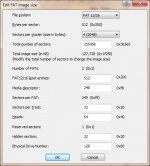carangil
Experienced Member
So, I have a 486 with a 3.5 inch floppy drive.
I was putting in a new HD, and needed to make a boot floppy. I had so much trouble with this! I took a stack of random old floppies of mine, that don't have any data I care about, and tried to format them. I also tried them in my non-vintage k6 machine's floppy drive.
I've found this:
-Most of the old ones were ok
-The really old ones were garbage
-Most of the more modern ones (early 2000's) would either refuse to format, or formatted full of bad spots.
I finally succeeded at getting a good boot disk and got a basic DOS install on the HD, just enough to load CD drivers and load everything else via the more reliable optical media.
I would now like to clean (or perhaps replace) the floppy drives in both machines, and get a good stock of disks.
Can anyone recommend a good brand of source of 3.5 inch floppies? Should I try to buy old unopened packages from the 90's? Are any of the boxes for sale currently in stores (say the back corner of Fry's) have a chance of being good?
I think what it comes down to is should I try a) new, but crap, media or b) quality, but aged media. Both sound kinda dubious in reliability. Or, am I barking up the wrong tree, and should switch over to 5.25 media?
I suppose what Im asking, is, If you were to format a DOS boot disk and hide the disk somewhere, when you find it a couple years from now, which type of disk would you expect to still boot?
I was putting in a new HD, and needed to make a boot floppy. I had so much trouble with this! I took a stack of random old floppies of mine, that don't have any data I care about, and tried to format them. I also tried them in my non-vintage k6 machine's floppy drive.
I've found this:
-Most of the old ones were ok
-The really old ones were garbage
-Most of the more modern ones (early 2000's) would either refuse to format, or formatted full of bad spots.
I finally succeeded at getting a good boot disk and got a basic DOS install on the HD, just enough to load CD drivers and load everything else via the more reliable optical media.
I would now like to clean (or perhaps replace) the floppy drives in both machines, and get a good stock of disks.
Can anyone recommend a good brand of source of 3.5 inch floppies? Should I try to buy old unopened packages from the 90's? Are any of the boxes for sale currently in stores (say the back corner of Fry's) have a chance of being good?
I think what it comes down to is should I try a) new, but crap, media or b) quality, but aged media. Both sound kinda dubious in reliability. Or, am I barking up the wrong tree, and should switch over to 5.25 media?
I suppose what Im asking, is, If you were to format a DOS boot disk and hide the disk somewhere, when you find it a couple years from now, which type of disk would you expect to still boot?

